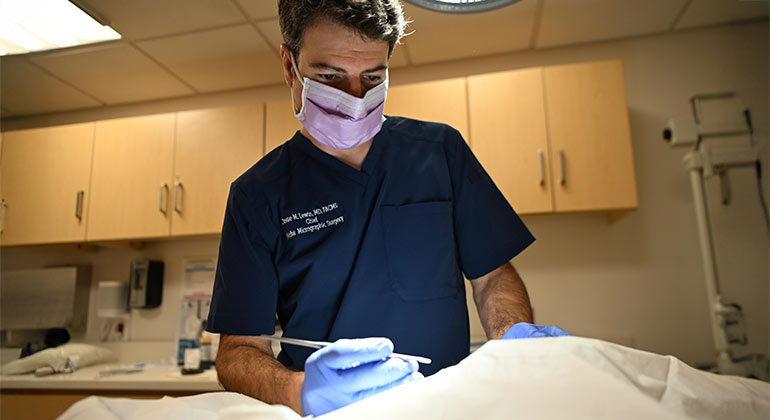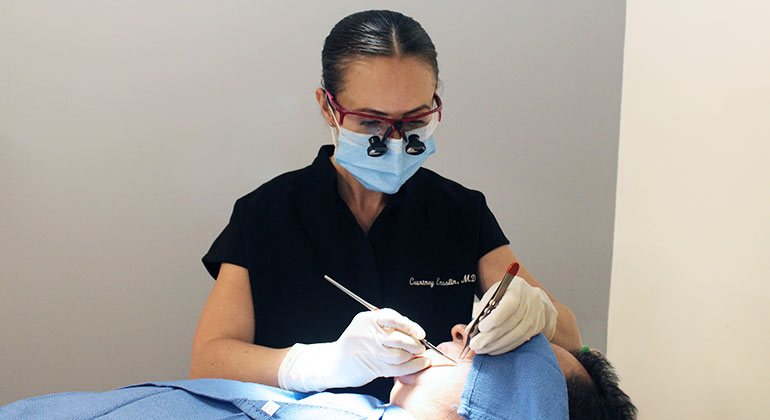Mohs Micrographic Surgery


Mohs surgery is the most effective treatment for most types of skin cancer including basal cell carcinoma (BCC) and squamous cell carcinoma (SCC). With the Mohs technique, we can precisely identify and remove an entire tumor while leaving the surrounding healthy tissue intact and unharmed.
The Kimberly and Eric J. Waldman Department of Dermatology at Mount Sinai is a world leader in this procedure. We have cured more than 50,000 skin cancers with this procedure and continue to perform more than 2,000 cases a year. We also have an extensive Mohs training program for dermatologists.
The Mohs procedure involves surgically removing skin cancer layer-by-layer. We examine each layer under a microscope until we reach healthy, cancer-free tissue around the tumor (called a clear margin). Mohs surgeons are trained as a cancer surgeon, pathologist, and reconstructive surgeon. Mohs surgery has the highest success rate of all treatments for skin cancer–up to 99 percent.
Advantages of Mohs surgery include:
- Ensuring complete cancer removal during surgery, dramatically decreasing the chance of cancer growing back
- Minimizing the amount of healthy tissue lost
- Maximizing the functional and cosmetic outcome
- Providing a highly effective approach to cancer treatment
Other skin cancer treatment methods estimate the amount of tissue that needs to be treated, which can result in the unnecessary removal of healthy skin tissue and tumor re-growth if any cancer is missed.
Why Choose Mohs Surgery
Because of Mohs surgery's high success rate, most patients require only a single surgery. This procedure usually includes the repair of the wound as well. Other methods might require additional surgeries and pathology readings in order to repair the wound and to treat the cancer if it is not completely removed. Each of these additional surgeries and pathology readings require separate fees and affects the surrounding tissue.
Mohs surgery minimizes the emotional toll as well. You do not have to wait for the results of one procedure and schedule another. In addition, since Mohs minimizes the risk of recurrence, it leads to peace of mind. It also reduces the costs of larger, more serious surgeries for recurrent skin cancers.
Mohs Micrographic Surgery with MART-1
Notably, Mount Sinai is the only academic medical center in New York City that uses a special stain called MART-1 during surgery to highlight melanoma cells under the microscope for immediate, same-day excision of early melanoma. This avoids sending you home and coming back to have the surgery about a week later, after the pathology test results come in.
Before Surgery
There are a few things you can do to prepare for Mohs surgery. Stop taking ibuprofen (such as Advil or Motrin) or other oral non-steroidal anti-inflammatory drugs (NSAIDs) seven days before surgery. You should check with your doctor about other blood-thinning medications such as aspirin, heparin, dipyridamole (Persantine), pentoxifylline (Trental), clopidogrel (Plavix), prasugrel (Effient), ticagrelor (Brilinta), warfarin (Coumadin), dabigatran (Pradaxa), rivaroxaban (Xarelto) and apixaban (Eliquis). You should avoid taking any herbal medications (such as St. John’s wort, ginkgo biloba, vitamin E, garlic, ginseng, fish oil) that predispose you to bleeding and bruising. Do not drink alcohol for 48 hours prior to surgery.
On the morning of surgery, you should eat a normal breakfast and take your regular medications. Wear comfortable clothing. You may want to bring something to read or pass the time because there will be waiting time between stages of Mohs surgery.
Typically, surgery starts early in the morning and is completed the same day, depending on the extent of the tumor and the amount of reconstruction necessary.
Removing the Tumor
We start by numbing your skin with a local anesthetic. This means that you are awake and comfortable during the entire procedure. Using a local anesthesia rather than general anesthesia shortens the recovery time and decreases possible side effects.
Your Mohs surgeon starts by removing the visible tumor and a thin layer of surrounding tissue. Then a technician prepares this tissue on slides for your surgeon to examine under a microscope. If the surgeon sees evidence of cancer around the outer edges of the removed tissue, he or she takes another layer of tissue from the area where the cancer was detected. This approach ensures that we remove only cancerous tissue and a small margin of clean tissue, minimizing the loss of healthy tissue. Your surgeon repeats these steps until all samples are free of cancer. It usually takes one to three stages to completely remove the tumor with clean margins.
Reconstruction
Once we are confident that all the cancer is removed, we can reconstruct the remaining skin. The Mohs surgeon can usually do this immediately after the tumor removal stage. Sometimes we delay reconstruction to a later day.
Our goal with reconstruction is to leave the least visible scar possible. When we plan reconstruction, we take into consideration the tumor’s size, depth, and location as well as your preferences.
While your surgeon might be able to give you an idea of whether your reconstruction should take place immediately after surgery or be delayed until later, it is impossible to know the extent of the cancer in advance.
Typically, we use one of these reconstruction options:
- We allow small, simple wounds to heal by themselves (called secondary-intention healing)
- We close slightly larger wounds with side-to-side stitches
- For larger or more complicated wounds, we may use a skin graft from another are of the body or close the wound with a flap using skin adjacent to the wound
- We may refer you to another reconstructive surgical specialist such as a Mount Sinai specialized oculoplastic surgeon or a facial plastic surgeon
After the Procedure
You should have little or no pain after the procedure. Acetaminophen (Tylenol®) or, in rare instances, a stronger painkiller such as ketorolac (Toradol®), should take care of any discomfort. Major complications are rare with Mohs surgery. You may experience some minor swelling and bruising, but that will fade in a few days. Some people have an allergic reaction to the adhesive tape, but that too goes away quickly. If you have any minor bleeding, just apply firm pressure to the area. Infections are rare, but easily treated with antibiotics.
Healing time varies, depending on your age, medical history, and type of operation. Sutured wounds usually heal in two to three weeks. Skin grafts may take a month or two. For wounds that heal by granulation (secondary-intention), the healing time is usually one to three months. We will give you specific aftercare instructions before you leave our office.
You will return to your Mohs surgeon at Mount Sinai who will remove the sutures and change the dressing. We normally see you after one week for procedures on the face or neck and two weeks for procedures performed on the body or limbs. We also schedule follow-up appointments after a month or two to discuss treatments that can improve scars.
Because you have had skin cancer, you should see your dermatologist regularly for cancer checks and if you notice any concerning changes on your skin. The Kimberly and Eric J. Waldman Melanoma and Skin Cancer Center can provide more information on the treatments and clinical trials for the different types of skin cancer.